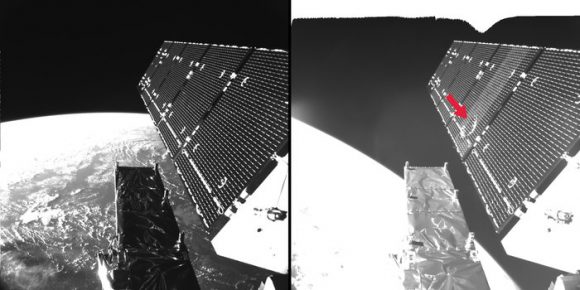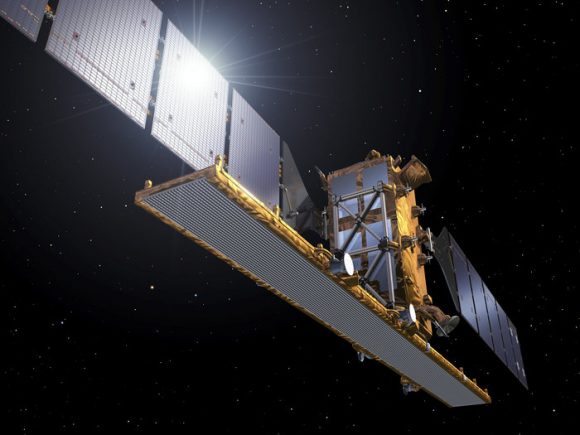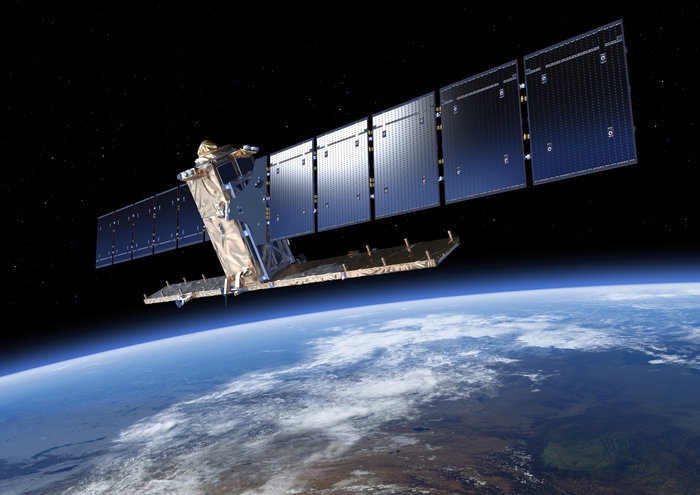One of the worst things that can happen during an orbital mission is an impact. Near-Earth orbit is literally filled with debris and particulate matter that moves at very high speeds. At worst, a collision with even the smallest object can have catastrophic consequences. At best, it can delay a mission as technicians on the ground try to determine the damage and correct for it.
This was the case when, on August 23rd, the European Space Agency’s Sentinel-1A satellite was hit by a particle while it orbited the Earth. And after several days of reviewing the data from on-board cameras, ground controllers have determined what the culprit was, identified the affected area, and concluded that it has not interrupted the satellite’s operations.
The Sentinel-1A mission was the first satellite to be launched as part of the ESA’s Copernicus program – which is the worlds largest single earth observation program to date. Since it was deployed in 2014, Sentinel-1A has been monitoring Earth using its C-band Synthetic Aperture Radar, which allows for crystal clear images regardless of weather or light conditions.

In addition to tracking oil spills and mapping sea ice, the satellite has also been monitoring the movement of land surfaces. Recently, it provided invaluable insight into the earthquake in Italy that claimed at least 290 lives and caused widespread damage. These images were used by emergency aid organizations to assist in evacuations, and scientists have begun to analyze them for indications of how the quake occurred.
The first indication that something was wrong came on Tuesday, August 23rd, at 17:07 GMT (10:07 PDT, 13:07 EDT), when controllers noted a small power reduction. At the time, the satellite was at an altitude of 700 km, and slight changes in it’s orientation and orbit were also noticed.
After conducting a preliminary investigation, the operations team at the ESA’s control center hypothesized that the satellite’s solar wing had suffered from an impact with a tiny object. After reviewing footage from the on-board cameras, they spotted a 40 cm hole in one of the solar panels, which was consistent with the impact of a fragment measuring less than 5 mm in size.
However, the power loss was not sufficient to interrupt operations, and the ESA was quick to allay fears that this would result in any interruptions of the Sentinel-1A‘s mission. They also indicated that the object’s small size prevented them from advanced warning.

As Holger Krag – Head of the Space Debris Office at ESA’s establishment in Darmstadt, Germany – said in an agency press release:
“Such hits, caused by particles of millimeter size, are not unexpected. These very small objects are not trackable from the ground, because only objects greater than about 5 cm can usually be tracked and, thus, avoided by maneuvering the satellites. In this case, assuming the change in attitude and the orbit of the satellite at impact, the typical speed of such a fragment, plus additional parameters, our first estimates indicate that the size of the particle was of a few millimeters.
While it is not clear if the object came from a spent rocket or dead satellite, or was merely a tiny clump of rock, Krag indicated that they are determined to find out. “Analysis continues to obtain indications on whether the origin of the object was natural or man-made,” he said. “The pictures of the affected area show a diameter of roughly 40 cm created on the solar array structure, confirming an impact from the back side, as suggested by the satellite’s attitude rate readings.”
In the meantime, the ESA expects that Sentinel-1A will be back online shortly and doing the job for which it was intended. Beyond monitoring land movements, land use, and oil spills, Sentinel-1A also provides up-to-date information in order to help relief workers around the world respond to natural disasters and humanitarian crises.
The Sentinel-1 satellites, part of the European Union’s Copernicus Program, are operated by ESA on behalf of the European Commission.
Further Reading: Sentinel-1


Thanks. I’m amazed that they can track objects as small as 5 cm. I wonder what the collision velocity might have been.
You misread the article or made a typo? “…less than 5 mm in size.”
@Aqua4U — What I was looking at was: “Such hits, caused by particles of millimeter size, are not unexpected. These very small objects are not trackable from the ground, because only objects greater than about 5 cm can usually be tracked and, thus, avoided by maneuvering the satellites….” Where did I get it wrong?
Bit of confusion, I think. They can only track objects larger than 5cm in diameter, which is why they didn’t detect the object which hit the satellite – which was 5mm in diameter.
My bad… I obviously misread your post.
@ronfurg: The approximate “speed limit” for colliding objects is ~2x the escape velocity of the object they’re both orbiting: around the Sun @1AU it’s ~80 km/sec; for Earth orbit it’s ~20 km/sec. On the low end, small objects in orbits traveling in the same general direction can have collision speeds of just a few cm/sec, so our hypothetical range of impact velocities is a few cm/sec to 80 km/sec, with 5 km/sec (man-made co-orbiting) to 50 km/sec (cometary) as a likely range.
Since we know the composition of the solar panels, we can calculate the force and the angle of impact needed to make the observed hole, much like a crime scene investigator using ballistics can re-create a shooting. We can also use the change in the satellite’s attitude/orbit post-impact to calculate the angle & amount of the force imparted to the satellite, which may help to further refine the range of sizes, speeds & materials involved.
Even in the absence of super-precise data, it should eventually be possible to determine whether the object was in a similar orbit to the satellite and thus likely on the larger, slower side (probably man-made, 2 mm – 5 mm across, e.g. paint flakes or even a mechanical nut), or whether it was a smaller, higher speed object (more likely natural, <2 mm across, e.g. cometary sand or dust) which was on its way to becoming a shooting star.
Any smaller, and they are almost transparent to tracking radar at that distance because of the wavelength of the radar itself. They don’t reflect enough of a signal to be recognized by the receiver.
But, that impact damage! Wow. A 40cm damage circumference from a 1mm impactor. And of course, the impact itself created new debris. Next thing you know, George’s Clooney’s ghost is going to smack into the Hubble.
Whoa! 40cm = 15.75 inches… that’s a pretty big hole! I wouldn’t want THAT to hit my spacesuit… NO!
As far as Earth’s orbital space being “literally full” of debris, I’m going to ignore the artistic hyperbole for an attempt at some perspective:
1) The volume of Earth’s orbital space (100 km to GEO) is ~6100 x bigger than the atmosphere (0 to 100 km).
2) There are twice as many pigeons — just pigeons — as there are orbital objects of ANY size.
3) All space debris combined weighs less than 2 dozen jumbo jets, >90% of which is found in ~100 known, tracked objects; some 5,000 commercial jets are in the air over the US right now.
According to http://www.flightradar24.com, some 12,000 commercial flights are in the air world-wide as I type. Non-commercial flights typically outnumber commercial ones by a factor of 2. As such, it is likely that the Earth’s atmosphere contains more flying airplanes than its orbital space contains debris >10 cm, despite being >6,000 x smaller. Throw in all the birds, insects, hail stones and other naturally occurring airborne objects, add in the balloons, ultra-lights, drones, gliders & sky-divers, and finally concentrate them into the bottom 20% of the atmosphere… well, someone prone to worry might be forgiven for wondering how a 747 could even take off, let alone fly anywhere safely, right?
No one here wants to see the Kessler Syndrome in real life (least of all those of us making a living off of orbiting machinery!), but the chance of “Gravity” happening any time soon just isn’t realistic.
@Smokey Thanks so much for taking to time to throw additional light on this space debris issue. This is really amazing information.